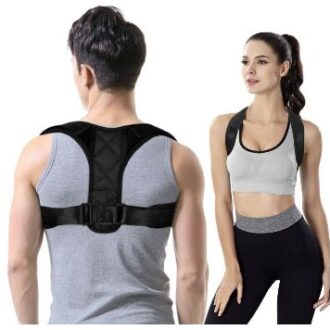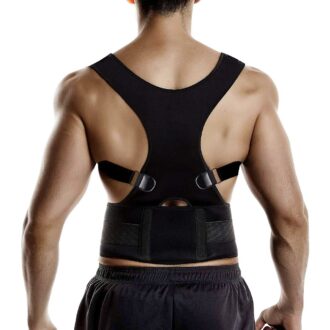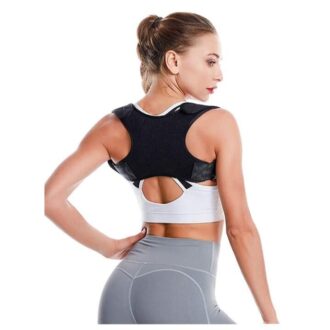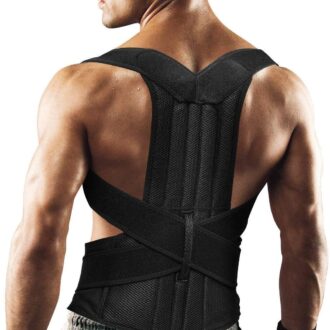No products in the cart.
Posture Correctors
Posture Corrector Belt
- 1x Posture Corrector Belt designed by BackReviver™ to support and realign your hips and lower back helping to improve your overall posture and prevent back injuries
- For both Men & Women
- Available in a range of different sizes:
Medium – 2.1-2.4 feet or 25.2 Inches – 28.8 Inches
Large – 2.4-2.7 feet or 28.8 Inches – 32.4 Inches
Extra Large 2.7-3 feet or 32.4 Inches – 36 Inches - Recommended for treating and easing back injuries and conditions including Sciatica, Slipped discs, Herniated discs, Degenerative disc disease, Facet syndrome, Lumbar spinal stenosis, Scoliosis, spondylolisthesis, Muscle or ligament strain as well as Arthritis and Osteoarthritis
- Inbuilt support rods realign and hold your hips and lower back in the correct position easing strain and pressure off your spine and prevent movement which could cause damage to your back
- Provides soothing compression that boosts blood flow to your lower back helping soothes aches and pains and reduces inflammation, swelling and soreness after sustaining an injury
- Ideal for wearing whilst exercising, weightlifting and playing sports to improve your posture and form and provide extra support and protection to help prevent back injuries from occurring
- Adjustable straps wrap around your body allowing you to quickly change the level of support and compression and keep the posture corrector belt securely in place preventing it from moving around and rubbing and chaffing your body
- Made from lightweight, breathable and non bulky materials that wick moisture away and keep your back dry and sweat free all day long
- Includes 30 day money back guarantee!
£16.99inc VATPosture Corrector
- 1x Posture corrector designed to improve your posture and ease neck, shoulder and back pain
- For both men and women
- One size fits all
- Comfortable and easy to wear. Simply put the posture corrector on like a backpack and use the adjustable Velcro straps to adjust to the right support and fit that you need
- Helps you stand taller and with more confidence in yourself
- Eases pressure off your back by realigning and holding your neck, shoulders and upper back in the correct position helping to prevent injury and pain caused by poor posture
- Prevents the most common back and posture problems such as slouching, hunching forward, sway back, thoracic kyphosis, lumbar lordosis, rounded shoulders and forward head to help ease pressure off your neck, shoulders and upper back
- Made from high quality materials that are soft, padded, lightweight and breathable ensuring maximum comfort no matter how long you wear the posture corrector for
- Ideal for general everyday use and wearing whilst playing sports or running for extra support and protection
- Includes full 30 day money back guarantee!
£9.99£14.99inc VATMagnetic Posture Corrector
- 1x Magnetic Posture corrector Back Brace specially designed to help improve posture, ease lower and upper back pain and make you stand taller with more confidence
- For both Men & Women
- Sizes are as follows: Small = 80CM (for height under 150cm), Medium = 90CM (for height up to 160cm), Large = 100cm (for height up to 170cm),
XL = 110cm (for height up to 185cm), XXL= 120cm (for height 195+cm) - Features fully adjustable buckle straps that allow you to quickly and easily adjust the posture corrector with total ease to the right fit
- Designed to ease pressure and strain off your back by improving your posture and correcting the position and alignment of your spine
- The inbuilt magnets provide soothing magnetic therapy giving you targeted and deep reaching pain relief for back aches and pain (Not recommended for those who use a pacemaker)
- Provides soothing compression that helps to ease aches and pain and boost blood flow to your back helping speed up the natural healing process of injured backs
- Can be worn to help ease a wide range of back injuries and conditions including slipped discs, Sciatica, spondylolisthesis, Muscle or ligament strain, Arthritis and Osteoarthritis
- Made form lightweight and breathable materials with moisture wicking abilities that keep you dry and sweat free
- Includes a full 30 day money back guarantee!
Warning! Please note this item contains Magnets and so it can potentially interfere with pacemakers, defibrillators, and other medical implants that could be affected by magnets. Do not buy this item if you have an implanted medical device, we cannot be held liable for any damage caused wearing this product.£15.99inc VATShoulder posture brace
- 1x Shoulder posture brace designed to improve posture and ease strain and pressure off your upper back and neck
- For both Men & Women
- One size fits all featuring secure adjustable straps that help you find the support and compression that is right for you
- Supports your Shoulders, Neck and upper back correctly helping you stand taller with more confidence
- Great for injury rehabilitation – Provides soothing compression that eases pain, reduces swelling and boosts blood flow to your upper back helping speed up the natural healing process
- Straightens your back and align your spine into the correct position – Designed to prevent rounded shoulders, slouching and hunching forward common causes of bad posture, back pain and injuries
- Features padded shoulder pads designed to prevent the brace from cutting into your arms and body whilst wearing allowing you to comfortably wear the brace all day long
- The perfect choice for improving your posture whilst exercising, running or playing sports such as football
- Breathable holes help circulate air and keep you dry, sweat free and feeling fresher for longer
- The slim discreet design makes this posture brace ideal for wearing underneath clothing without any bulkiness
- Includes a full 30 day money back guarantee!
£12.99£14.99inc VATPosture corrective brace
- 1x Posture corrective brace designed to improve posture and ease back aches and pains
- For Both Men & Women
- Available in a range of different sizes with two fully adjustable straps that wrap around your body giving you the support and fit that you need
- The two inner supportive rods that help realign and straighten your spine helping to ease tension and pressure off your back
- Helps prevent the most common causes of bad posture such as slouching and rounded shoulders
- Provides soothing compression to your upper and lower back helping to ease pain and improve circulation
- Features comfortable padded arm straps that wont cut into your shoulders or body whilst wearing the brace
- Made from lightweight breathable materials with a padded inner layer for extra comfort and protection making this posture brace ideal for wearing all day long
- Can be worn to help treat and prevent a wide variety of back problems and injuries including Slipped disc, Sciatica, Facet syndrome, Lumbar spinal stenosis, spine kyphosis, osteoporosis, neck or shoulder pain, and backache
- Includes a full 30 day money back guarantee!
- Available in sizes Small, Medium, Large, XL & XXL, 3XL and 4XL with two easy to use adjustable straps help you find the right support and fit for you.
- The maximum length of the belt are as follows measuring below the rib cage and around the stomach area (note this is adjustable downwards):
- M (Max length 100cm (39.37 inches)), L ( Max Length 102cm (40.15 inches)), XL (Max Length 104cm (40.9 inches)), 2XL (Max Length 106cm (41.7 inches)), 3XL (Max Length 108cm (42.5 inches)), 4XL (Max Length 110cm (43.3inches))
£15.99inc VAT




